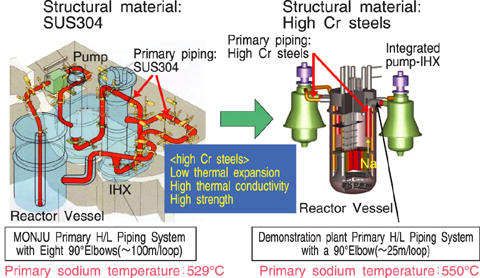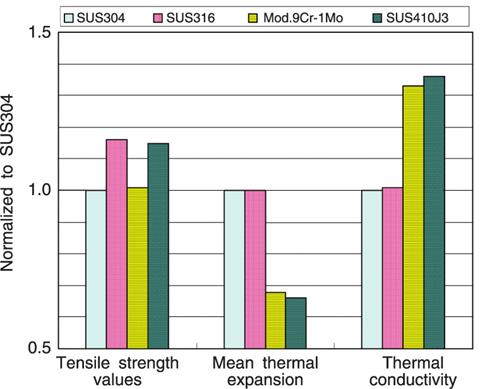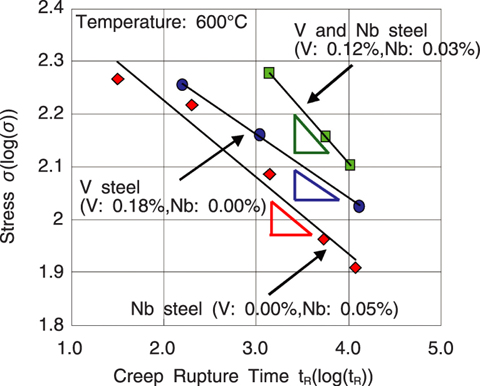
Fig.1-2 Pipe shortening by employing high Cr steel

Fig.1-3 Material properties of stainless steels and high Cr steels

Fig.1-4 Effects of vanadium and/or niobium on creep strength
Applicability of high chromium (Cr) steel as a main structural material in FBR has been explored to enhance the economic competitiveness of the FBR. Since this steel has excellent high temperature strength and thermal properties, the coolant pipes can be shortened and a compact plant design can be achieved (Fig.1-2). Applicability of Mod. 9Cr-1Mo steel has been investigated for the demonstration plant because the steel has proven performance in thermal power boilers. For a commercial plant, however, development of innovative high Cr steel is required to enhance the economic competitiveness. Some conventional high Cr steels have properties superior to those of Mod. 9Cr-1Mo steel, as shown in Fig.1-3. However, such steels cannot be used in the FBR components directly, because their long term stability at elevated temperature has not demonstrated yet. In addition, excellent creep-fatigue strength and fracture toughness are required in the FBR structural material. Therefore, prior to employing the steels in the FBR components, it is required that these properties be improved.
Though high temperature strength of the high Cr steel has been achieved by adding some strengthening elements such as vanadium (V) and niobium (Nb), long term efficiency and stability of strengthening elements has not been confirmed yet. Therefore, the long term effectiveness and stability of V and Nb were investigated.
Generally, both V and Nb contribute to improve the high temperature strength of high Cr steels by precipitating as fine carbides and/or nitrides (VX and NbX, where X is C or N; all of these termed "MX"). Several trial products in which the V and Nb contents were varied were made, and mechanical tests and metallurgical examinations were conducted to investigate the long term effectiveness and stability of the precipitation strengthening. As shown in Fig.1-4, both creep strength and long term stability depend on the V and Nb content. Metallurgical examinations revealed that VX was stable after long term creep and aging. This result shows that precipitation of VX in high Cr steel is an efficient strengthening method for FBR components. Based on the above investigations, the stability of precipitation strengthening can be enhanced by controlling the V and Nb content.
<Previous: 1 Research and Development of Advanced Nuclear System | Next: 1-2 >